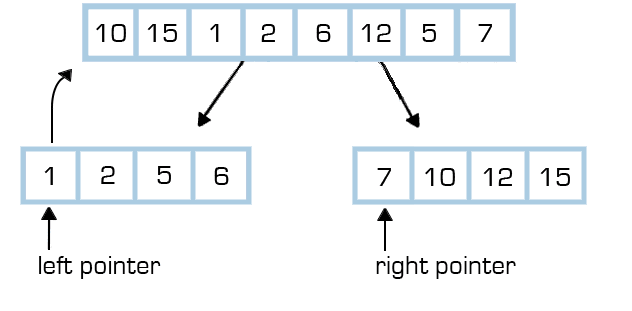Mastering the Two-Pointer Technique in Java: A Detailed Guide
 SANTOSH SINGH
SANTOSH SINGHTable of contents
- What is the Two-Pointer Technique?
- When to Use the Two-Pointer Technique?
- Example 1: Finding a Pair with a Given Sum
- Example 2: Removing Duplicates from a Sorted Array
- Example 3: Merging Two Sorted Arrays
- Example 4: Container With Most Water
- Example 5: Palindrome Checking
- Example 6: Partitioning Arrays (Dutch National Flag Problem)
- Why the Two-Pointer Technique is Efficient
- Other Applications of the Two-Pointer Technique
- Conclusion

What is the Two-Pointer Technique?
The two-pointer technique is a pattern often used in scenarios where you need to search for pairs in a sequence or compare elements in a sorted array or list. As the name suggests, it involves using two pointers, typically initialized at different positions, which traverse the data structure according to specific conditions.
When to Use the Two-Pointer Technique?
This technique is most useful in problems like:
Finding pairs in a sorted array that sum up to a target value.
Removing duplicates from a sorted array.
Merging two sorted arrays.

Solving problems related to palindromes or detecting subarrays with specific properties.
Finding the maximum area of water that can be contained between lines (Container with Most Water problem).
Partitioning arrays based on certain conditions.
Example 1: Finding a Pair with a Given Sum
Let's start with a classic problem where the two-pointer method shines: finding a pair of numbers in a sorted array that add up to a given sum.
Problem Statement:
Given a sorted array of integers and a target sum, find the pair of numbers in the array that add up to the target.
Approach:
Initialization: Set one pointer at the beginning (
left) and the other at the end (right) of the array.Iteration:
If the sum of the elements at the two pointers equals the target, return the pair.
If the sum is less than the target, move the
leftpointer to the right to increase the sum.If the sum is greater than the target, move the
rightpointer to the left to decrease the sum.
Termination: The loop continues until the pointers meet.
Java Implementation:
public class TwoPointerExample {
public static int[] findPairWithSum(int[] nums, int target) {
int left = 0;
int right = nums.length - 1;
while (left < right) {
int sum = nums[left] + nums[right];
if (sum == target) {
return new int[]{nums[left], nums[right]};
} else if (sum < target) {
left++;
} else {
right--;
}
}
return new int[]{-1, -1}; // Return -1 if no pair is found
}
public static void main(String[] args) {
int[] nums = {1, 2, 3, 4, 6, 8, 10};
int target = 10;
int[] result = findPairWithSum(nums, target);
if (result[0] != -1) {
System.out.println("Pair found: " + result[0] + ", " + result[1]);
} else {
System.out.println("No pair found with the given sum.");
}
}
}
Output:
Pair found: 2, 8
Example 2: Removing Duplicates from a Sorted Array
Another common application of the two-pointer technique is removing duplicates from a sorted array in-place.
Problem Statement:
Given a sorted array nums, remove the duplicates in-place such that each element appears only once and returns the new length.
Approach:
Initialization: Use two pointers,
i(slow-runner) andj(fast-runner). Start both at the beginning of the array.Iteration:
Move
jforward and comparenums[j]withnums[i].If they are different, increment
iand assignnums[j]tonums[i].
Termination: The array up to index
iwill have no duplicates.
Java Implementation:
public class RemoveDuplicates {
public static int removeDuplicates(int[] nums) {
if (nums.length == 0) return 0;
int i = 0; // Pointer for the position of the last unique element
for (int j = 1; j < nums.length; j++) {
if (nums[j] != nums[i]) {
i++;
nums[i] = nums[j];
}
}
return i + 1; // Length of array without duplicates
}
public static void main(String[] args) {
int[] nums = {1, 1, 2, 3, 3, 4, 4, 5};
int newLength = removeDuplicates(nums);
System.out.print("Array after removing duplicates: ");
for (int k = 0; k < newLength; k++) {
System.out.print(nums[k] + " ");
}
}
}
Output:
Array after removing duplicates: 1 2 3 4 5
Example 3: Merging Two Sorted Arrays
The two-pointer technique is ideal for merging two sorted arrays into one sorted array efficiently.
Problem Statement:
Given two sorted arrays arr1 and arr2, merge them into a single sorted array.
Approach:
Initialization: Use two pointers,
iforarr1andjforarr2.Iteration:
Compare the elements at
arr1[i]andarr2[j].Add the smaller element to the merged array and move the corresponding pointer.
Termination: Once one array is exhausted, append the remaining elements of the other array.
Java Implementation:
import java.util.Arrays;
public class MergeSortedArrays {
public static int[] mergeArrays(int[] arr1, int[] arr2) {
int[] merged = new int[arr1.length + arr2.length];
int i = 0, j = 0, k = 0;
// Merge until one array is exhausted
while (i < arr1.length && j < arr2.length) {
if (arr1[i] < arr2[j]) {
merged[k++] = arr1[i++];
} else {
merged[k++] = arr2[j++];
}
}
// Append remaining elements
while (i < arr1.length) {
merged[k++] = arr1[i++];
}
while (j < arr2.length) {
merged[k++] = arr2[j++];
}
return merged;
}
public static void main(String[] args) {
int[] arr1 = {1, 3, 5, 7};
int[] arr2 = {2, 4, 6, 8, 10};
int[] merged = mergeArrays(arr1, arr2);
System.out.println("Merged Array: " + Arrays.toString(merged));
}
}
Output:
Merged Array: [1, 2, 3, 4, 5, 6, 7, 8, 10]
Example 4: Container With Most Water
This problem involves finding two lines that together with the x-axis form a container, such that the container contains the most water.
Problem Statement:
Given an array height where each element represents the height of a vertical line at that index, find two lines that together with the x-axis form a container that holds the most water.
Approach:
Initialization: Use two pointers,
leftat the start andrightat the end of the array.Iteration:
Calculate the area formed by the lines at
leftandright.Move the pointer pointing to the shorter line inward to potentially find a larger area.
Termination: Continue until the pointers meet.
Java Implementation:
public class ContainerWithMostWater {
public static int maxArea(int[] height) {
int left = 0, right = height.length - 1;
int maxArea = 0;
while (left < right) {
// Calculate the area
int width = right - left;
int minHeight = Math.min(height[left], height[right]);
int currentArea = width * minHeight;
// Update max area if needed
maxArea = Math.max(maxArea, currentArea);
// Move the pointer pointing to the shorter line
if (height[left] < height[right]) {
left++;
} else {
right--;
}
}
return maxArea;
}
public static void main(String[] args) {
int[] height = {1,8,6,2,5,4,8,3,7};
System.out.println("Maximum area: " + maxArea(height));
}
}
Output:
Maximum area: 49
Example 5: Palindrome Checking
Using the two-pointer technique, you can efficiently check if a given string is a palindrome.
Problem Statement:
Determine whether a given string is a palindrome, considering only alphanumeric characters and ignoring cases.
Approach:
Initialization: Use two pointers,
leftat the start andrightat the end of the string.Iteration:
Move
leftforward andrightbackward until alphanumeric characters are found.Compare the characters at
leftandright.If they don't match, the string is not a palindrome.
Termination: If all corresponding characters match, the string is a palindrome.
Java Implementation:
public class PalindromeChecker {
public static boolean isPalindrome(String s) {
int left = 0, right = s.length() - 1;
while (left < right) {
// Move left pointer to the next alphanumeric character
while (left < right && !Character.isLetterOrDigit(s.charAt(left))) {
left++;
}
// Move right pointer to the previous alphanumeric character
while (left < right && !Character.isLetterOrDigit(s.charAt(right))) {
right--;
}
// Compare characters
if (Character.toLowerCase(s.charAt(left)) != Character.toLowerCase(s.charAt(right))) {
return false;
}
left++;
right--;
}
return true;
}
public static void main(String[] args) {
String s1 = "A man, a plan, a canal: Panama";
String s2 = "race a car";
System.out.println("\"" + s1 + "\" is a palindrome? " + isPalindrome(s1));
System.out.println("\"" + s2 + "\" is a palindrome? " + isPalindrome(s2));
}
}
Output:
"A man, a plan, a canal: Panama" is a palindrome? true
"race a car" is a palindrome? false
Example 6: Partitioning Arrays (Dutch National Flag Problem)
This problem involves rearranging elements in an array based on a pivot value using the two-pointer approach.
Problem Statement:
Given an array containing only 0s, 1s, and 2s, sort the array in-place so that all 0s come first, followed by 1s, then 2s.
Approach:
Initialization: Use three pointers:
lowfor the next position of 0.midfor current element.highfor the next position of 2.
Iteration:
If the current element is 0, swap it with
lowand move bothlowandmidpointers forward.If the current element is 1, move the
midpointer forward.If the current element is 2, swap it with
highand move thehighpointer backward.
Termination: Continue until
midexceedshigh.
Java Implementation:
public class DutchNationalFlag {
public static void sortColors(int[] nums) {
int low = 0, mid = 0, high = nums.length - 1;
while (mid <= high) {
switch (nums[mid]) {
case 0:
swap(nums, low, mid);
low++;
mid++;
break;
case 1:
mid++;
break;
case 2:
swap(nums, mid, high);
high--;
break;
}
}
}
private static void swap(int[] nums, int i, int j) {
int temp = nums[i];
nums[i] = nums[j];
nums[j] = temp;
}
public static void main(String[] args) {
int[] colors = {2, 0, 2, 1, 1, 0};
sortColors(colors);
System.out.print("Sorted array: ");
for (int color : colors) {
System.out.print(color + " ");
}
}
}
Output:
Sorted array: 0 0 1 1 2 2
Why the Two-Pointer Technique is Efficient
The efficiency of the two-pointer technique lies in its ability to reduce the time complexity. In the above examples:
Finding a Pair with a Given Sum: Reduced from O(n²) to O(n).
Removing Duplicates: Achieved in O(n) time and O(1) space.
Merging Two Sorted Arrays: Performed in O(n + m) time, where n and m are the lengths of the arrays.
Container With Most Water: Solved in O(n) time.
Palindrome Checking: Done in O(n) time.
Dutch National Flag Problem: Sorted in O(n) time with a single pass.
This makes the two-pointer technique particularly useful in scenarios where performance is crucial, such as processing large datasets or in real-time applications.
Other Applications of the Two-Pointer Technique
Finding Subarrays with Specific Properties: Such as finding the smallest subarray with a given sum.
Sliding Window Problems: Where you need to find a window that satisfies certain conditions.
Intersection of Two Arrays: Finding common elements between two arrays.
Three-Sum and Four-Sum Problems: Extending the two-pointer approach for more complex scenarios.
Conclusion
The two-pointer technique is a powerful tool in your algorithmic arsenal. By mastering it, you can tackle a wide range of problems more efficiently. Whether you are preparing for coding interviews or just want to enhance your problem-solving skills, understanding and applying this method is a must. Practice with various problems to get comfortable with different scenarios where the two-pointer technique can be applied.
Subscribe to my newsletter
Read articles from SANTOSH SINGH directly inside your inbox. Subscribe to the newsletter, and don't miss out.
Written by
